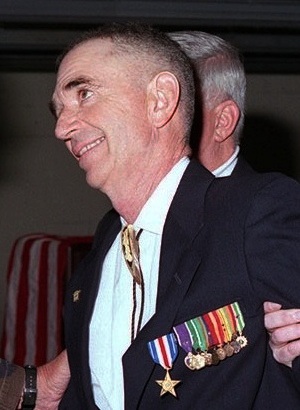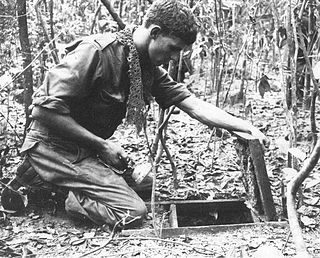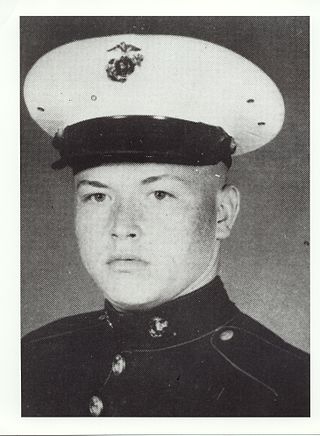
The Army of the Republic of Vietnam composed the ground forces of the South Vietnamese military from its inception in 1955 to the Fall of Saigon in April 1975. At the ARVN's peak, an estimated 1 in 9 citizens of South Vietnam were enlisted, composed of Regular Forces and the more voluntary Regional Forces and the Popular Force militias. It is estimated to have suffered 1,394,000 casualties during the Vietnam War.

Carlos Norman Hathcock II was a United States Marine Corps (USMC) sniper with a service record of 93 confirmed kills. Hathcock's record and the extraordinary details of the missions he undertook made him a legend in the U.S. Marine Corps. He was honored by having a rifle named after him: a variant of the M21 dubbed the Springfield Armory M25 White Feather, for the nickname "White Feather" given to Hathcock by the North Vietnamese People's Army of Vietnam (PAVN).

Holland McTyeire "Howlin' Mad" Smith, KCB was a general in the United States Marine Corps during World War II. He is sometimes called the "father" of modern U.S. amphibious warfare. His nickname, "Howlin' Mad" Smith, had been given to him by his troops in the Dominican Republic in 1916.

Philip Caputo is an American author and journalist. He is best known for A Rumor of War (1977), a best-selling memoir of his experiences during the Vietnam War. Caputo has written 18 books, including three memoirs, five books of general nonfiction, nine novels, and one book of short stories. His latest is the novel Memory and Desire which was published in 2023 by Arcade Publishing.

The 5th Marine Regiment is an infantry regiment of the United States Marine Corps based at Marine Corps Base Camp Pendleton, California. It is the most highly decorated regiment in the Marine Corps and falls under the command of the 1st Marine Division and the I Marine Expeditionary Force.

The Combined Action Program was a United States Marine Corps counterinsurgency tool during the Vietnam War. It was widely remembered by the Marine Corps as effective. Operating from 1965 to 1971, it placed a 13-member Marine rifle squad, augmented by a U.S. Navy Corpsman and strengthened by a Vietnamese militia platoon of older youth and elderly men, in or adjacent to a rural Vietnamese hamlet. In most cases, the Popular Forces militia members were residents of the hamlet who were either too young or too old to be drafted into the Army of the Republic of Vietnam (ARVN) or the Regional Forces. The entire unit of American Marines and Popular Forces militia members together was designated as a Combined Action Platoon (CAP).

Operation Crimp, also known as the Battle of the Ho Bo Woods, was a joint US-Australian military operation during the Vietnam War, which took place 20 kilometres (12 mi) north of Cu Chi in Binh Duong Province, South Vietnam. The operation targeted a key Viet Cong headquarters that was believed to be concealed underground, and involved two brigades under the command of the US 1st Infantry Division, including the 1st Battalion, Royal Australian Regiment which was attached to the US 173rd Airborne Brigade. Heavy fighting resulted in significant casualties on both sides, but the combined American and Australian force was able to uncover an extensive tunnel network covering more than 200 kilometres, at the cost of 8 Australians and 14 Americans killed and 29 Australians and 76 Americans wounded.

2nd Battalion, 3rd Marines (2/3) was an infantry battalion in the United States Marine Corps based out of Marine Corps Base Hawaii consisting of approximately 1,000 Marines and sailors. The battalion fell under the command of the 3rd Marine Regiment and the 3rd Marine Division. The battalion was deactivated in January 2022 as part of the Marine Corps' ongoing Force Design efforts.
Robert Russell Garwood is a former United States Marine. Often cited as the last verified American prisoner of war (POW) from the Vietnam War, Garwood was captured on September 28, 1965 by Việt Cộng forces near Da Nang, Quang Nam Province. He was taken to North Vietnam in 1969, and although he was reportedly released in 1973 along with the other U.S. POWs as part of the Paris Peace Accords, he did not return to the United States until March 22, 1979.

The 1st Battalion 9th Marines (1/9) was an infantry battalion of the United States Marine Corps. Formed during World War I, it served until the mid-2000s when it was deactivated to make room for one of three light armor reconnaissance battalions. During the Vietnam War, 1/9 sustained an especially high casualty rate as they faced extraordinary challenges and hardships during their tour. General Vo Nguyen Giap promised President Ho Chi Minh that he would wipe out the 1st Battalion, 9th Marines, as a present for the leader’s birthday. In describing the fate that awaited the Marines in the valley, Giap allegedly used the term "Di Bo Chet", translated as the “Walking Dead”. He viewed that the Marines should be considered already dead, just not buried yet. However, 1st Battalion, 9th Marines, proudly and defiantly adopted “The Walking Dead” as its nickname due to the unit's persistence and resilience.

Lance Corporal Joe Calvin Paul was a United States Marine killed in the Vietnam War who posthumously received the Medal of Honor for diverting an attack long enough to allow the evacuation of wounded Marines during Operation Starlite near Chu Lai, Vietnam, on August 18, 1965. The medal was awarded on February 7, 1967, during a ceremony in the Office of Secretary of the Navy Paul H. Nitze, who presented the award to his parents.

The Battle of Gang Toi was fought during the Vietnam War between Australian troops and the Viet Cong. The battle was one of the first engagements between the two forces during the war and occurred when A Company, 1st Battalion, Royal Australian Regiment struck a Viet Cong bunker system defended by Company 238 in the Gang Toi Hills, in northern Bien Hoa Province. It occurred during a major joint US-Australian operation codenamed Operation Hump, involving the US 173rd Airborne Brigade, to which 1 RAR was attached. During the latter part of the operation an Australian rifle company clashed with an entrenched company-sized Viet Cong force in well-prepared defensive positions. Meanwhile, an American paratroop battalion was also heavily engaged in fighting on the other side of the Song Dong Nai.

William Groom Leftwich Jr. was an officer of the United States Marine Corps who served during the Vietnam War. In 1970, he was killed in a helicopter crash during a combat mission in the Vietnam War.

Robert John Hibbs was a United States Army officer who graduated from the University of Northern Iowa and was a recipient of the United States military's highest decoration—the Medal of Honor—for his actions in the Vietnam War.

Major General Wayne Evan Rollings, USMC, was Commanding General, II Marine Expeditionary Force, III Marine Expeditionary Force and a recipient of the Navy Cross.

The 9th Marine Expeditionary Brigade was a United States Marine Corps unit.

Ernest Clifford Cheatham Jr. was a United States Marine Corps officer, a veteran of the Korean War and the Vietnam War, a recipient of the Navy Cross, and American football defensive tackle who played for the Baltimore Colts and the Pittsburgh Steelers.
The Vietnam War body count controversy centers on the counting of enemy dead by the United States Armed Forces during the Vietnam War (1955–1975). There are issues around killing and counting unarmed civilians (non-combatants) as enemy combatants, as well as inflating the number of actual enemy who were killed in action (KIA). For search and destroy operations, as the objective was not to hold territory or secure populations, victory was assessed by having a higher enemy body count.

Herman Nickerson Jr. was a highly decorated officer of the United States Marine Corps with the rank of lieutenant general. A veteran of several wars, he distinguished himself during the Korean War as commanding officer, 7th Marine Regiment and received the Distinguished Service Cross, the second highest military award that can be given to a member of the United States Armed Forces for extreme gallantry and risk of life in actual combat with an armed enemy force.

William Morgan Keys is a retired United States Marine lieutenant general. Keys was a combat veteran — receiving the Navy Cross for his heroic actions during the Vietnam War, as well as the Silver Star. Keys served as Commander, Marine Corps Forces Atlantic before retirement in 1994.

















